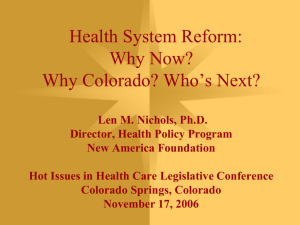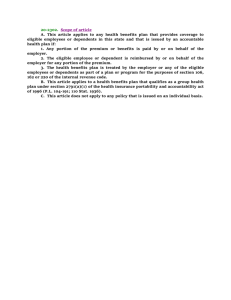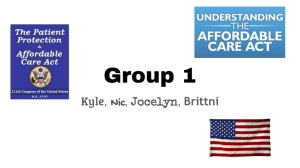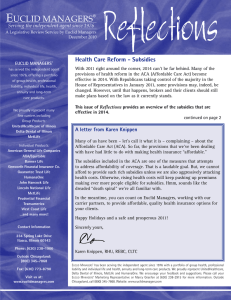F d l H lth R f Th R l
advertisement
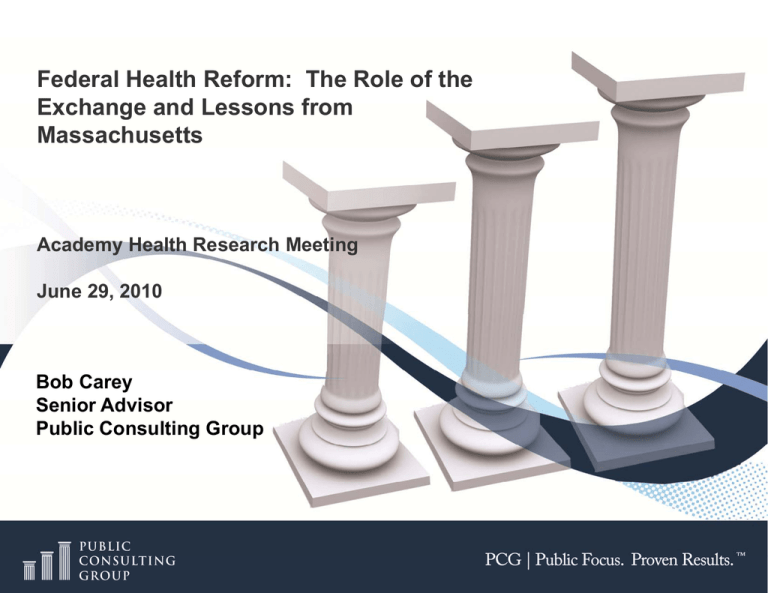
Federal F d l Health H lth Reform: R f The Th Role R l off the th Exchange and Lessons from Massachusetts Academy Health Research Meeting June 29, 2010 Bob Carey Senior Advisor Public Consulting Group Agenda Exchanges Under Federal Health Reform Eligibility and Premium Subsidies How Federal Exchanges Differ from the MA Connector Key Decision Points Lessons Learned from Massachusetts Page 2 Exchanges Under Federal Health Reform Single portal through which eligibility for publicly-subsidized insurance will be determined (Medicaid (Medicaid, SCHIP SCHIP, Exchange Exchange, and other public insurance programs) Commercial insurance marketplace for individuals and small groups Premium subsidies and lower cost-sharing for eligible individuals Sliding scale subsidies based on income from 133% – 400% FPL Medicaid expansion to cover residents up to 133% FPL State option to establish separate health insurance program for individuals with income from 133% - 200% FPL e s lawfully a u yp present” ese who oa are e not o e eligible g b e for o Medicaid ed ca d ca can receive ece e p premium e u subs subsidies, d es, “Aliens reduced cost sharing, and purchase insurance through the Exchange Small employers with lower-wage workers that purchase through the Exchange may be eligible for two two-year year tax credit to partially subsidize premiums Existing small group and individual markets will operate outside the Exchange Page 3 Exchange Structure Governance/oversight must be government agency or non-profit entity Allowed to subcontract functions, but not to health insurers Can only offer “qualified” health plans Plans grouped into five categories based on actuarial value: Platinum (90%) G ld (80%) Gold Silver (70%) Bronze (60%) C Catastrophic hi (Hi (High hD Deductible d ibl H Health l h Pl Plans - HDHP) [Purchase of HDHP’s limited to individual market; enrollees must be under 30-years old or exempt from individual mandate based on affordability or hardship] May also offer stand-alone dental plans Page 4 Exchange Functions Consumer Support Set up single portal to determine eligibility and enroll people in Medicaid, SCHIP, Exchange, and other public subsidy programs Set up call center/customer service unit with toll-free number for consumers Establish “Navigator” program for outreach and enrollment Distribution Channel for Commercial Insurance Establish carrier participation policies and procure health plans Assign g health p plan ratings g and p provide standardized information for consumers Develop web site through which people can shop for insurance Page 5 Exchange Functions Administrative Services and Operations Establish interface with health carriers to facilitate application of premium subsidies and cost-sharing reduction for eligible individuals Coordinate eligibility, reporting, premium subsidies, etc. with federal agencies Certify exemptions under the individual mandate Collect “Free Choice Vouchers” from ERs and apply vouchers to EEs premiums Possibly bill, collect and remit premiums to carriers Page 6 Eligibility g y Single Portal Eligibility Engine (No Wrong Door) 133% - 400% FPL* < 133% FPL (+5% income disregard) Works Doesn't Work Medicaid Eligible for premium subsidies, reduced cost sharing and purchase of insurance through the Exhange Employer Doesn't offer ESI Employer Offers ESI ESI meets 60% actuarial value ESI does not meet 60% actuarial value EE's Share of ESI premium >9.5% of EE's income EE's share of ESI premium 8% - 9.8% of income EE's Share of ESI premium <8% of EE's income EE not eligible for Exchange, not eligible for subsidies EE eligible for Free Choice Voucher through Exchange EE enrolls in ESI; no penalty Page 7 EE declines ESI; subject to penalty Premium Subsidies M r.and M rs.Jones M r.and M rs.Sm ith 4 6 $55,125 $73,825 Percentage ofFPL 250% 250% Fam ily Share as % of fIncom e 8.05% 8.05% Fam ily Share ofPrem ium (M onthly) $370 $495 Fam ily Size M odified Adjusted G rossIncom e Page 8 Premium Subsidies M r.and M rs.Jones n s M r.and M rs.Sm ith Fam ily Fam ily 40 60 Zip C ode 02139 02139 TotalM onthly Prem ium $1,600 $2,400 M em berShare ofPrem ium $370 $495 FederalShare ofPrem ium $1,230 $1,905 Rate Basis Type Age ofO ldestFam ily M em ber Page 9 How Exchanges g Differ from MA Connector M assachusetts C onnector FederalExchange Populations C overed AdultsO nly (children covered by M edicaid) Individuals and Fam ilies % FPL Eligible forSubsidies Up to 300% Up to 400% LevelofSubsidy y FlatPM PM based on FPL Bracket(e.g.,150-200% , 200-250% ,250-300% ) Sliding Scale,Setas % of Incom e Source ofC overage M CO s C om m ercialInsurers RegulatoryAuthority Extensive (e.g.,“m inim um creditable coverage,” affordability schedule) Lim ited Page 10 How Exchanges g Differ from MA Connector M assachusetts C onnect nn or Feder d alExchange ng Prem ium Billing,C ollection, Rem ittance to C arriers Handled by C onnector N otlisted as responsibility – TBD Interaction with Em ployer y s O ffering ESI N one forsubsidized population – Applicants ineligible forC onnectorbased subsidized coverage “Free C hoice Vouchers” – EEs m ay bring ER voucherto purchase coverage through Exchange Lighter Stick…Smaller Stick Smaller Carrots Page 11 Key y Decision Points First Level Decisions: Third Level Decisions: State or Federal Exchange Governance structure Benefits required beyond “essential health benefits” must be paid by the state Standardize plan designs or allow for market “creativity” “Open” Open or “selective” selective contracting with carriers and health plans Limit small group market to <50 EEs, prior i tto 2016 Premium billing, collection, remittance R l off b Role brokers/agents k / t Frequency of rate changes by carriers Who s responsible for administering the Who’s Exchange State-wide vs. regional vs. multi-state Exchanges Second Level Decisions: Separate program for individuals with income between 133 – 200% FPL Separate individual and small group Exchanges or combined Exchange What to out-source, what to in-source Page 12 Lessons Learned From Massachusetts Outreach is critical to ensure broad risk pool stabilize premiums pool, premiums, and attract sufficient volume Administrative efficiencies are contingent upon economies of scale Opportunity to streamline, consolidate or eliminate existing public subsidy programs Strategic contracting with carriers and vendors can help lower costs Inventory existing resources – public and private – to identify and leverage available infrastructure Page 13 Learned behavior can be difficult to overcome Continuous open enrollment in guaranteed issue, modified community rated individual market can create adverse selection problems for carriers Capitalize on health reform to promote other state priorities Accountable care organizations Medical home Payment reform Medicaid managed care organizations Cost containment strategies Contact Information Bob Carey Senior Advisor Public Consulting Group, Inc. Boston, MA 617-426-2026 x1345 rcarey@pcgus.com Page 14
